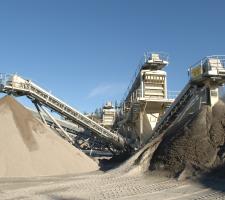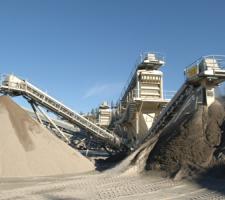
Call for higher performance is driving demand for both static and mobile screening plants
While the fundamental process of screening has remained unchanged for many years, tweaks in design have helped to deliver higher capacities and easier operation. Systems used to operate screens - both static and mobile - are increasingly being automated to improve function and give consistent productivity, while the move to mobile machines has added flexibility.
Although sales of mobile screens have been growing rapidly over the last decade, there is still very much a need for both these new comers and the larger static machines. So it is no surprise that calls for higher capacities, reduced maintenance and lower operating costs from customers applies to both types of machines.
"Static and mobile machines both have an equal market share these days," said
"Mobile plants do not always have the same specification but offer more flexibility and add the option for contract crushing and screening operations. Customers want more capacity so these demands have been met and the new technology is delivering higher quality materials.
"Some of the larger mobile screens can now equal that of a static plant but there is still a need for both types in the market. Demand for mobile plants is growing faster than static plants but there is a big difference in investment costs. Large urban areas need static plants to meet volume demands but in more remote locations, mobile units offer more flexibility."
This growth in contract screening is enabling operators to move to where demand is highest. As an extreme example of this, McCloskey sales manager Seamus Doyle explained that some Irish crushing and screening contractors have found work in Romania and transport their equipment there by road. "The Irish market is very quiet so they have gone to where there is demand," he said.
Operating costs
The costs of operating screening equipment is coming increasingly under scrutiny as operators try to reduce their cost per tonne of production. Smedenmen said, "All
Maintenance
In addition to improved capacity, many quarry operators are calling for machines that are easier to operate and require less maintenance.
"Mobile screening equipment is becoming more user friendly to reduce down time needed for media replacement and servicing," said Smedenmen. "The aim has been to enable a one person crew to be able to replace the media on their own so they can work effectively without external support." According to Metso Minerals' Denis Pradon, there are fewer and fewer maintenance specialists available so customers want machines that are user friendly and use fewer parts. "I expect that within 10 years we will see remote access technology allowing set up of the machine to be controlled from the office and to be able to access real time information on the screen this way," he said.
Environment
"Dust encapsulation started on static screens but is now spreading to the mobile market," said Svensson. "Dust encapsulation for mobile units is becoming more user friendly to allow for effective dust reduction but also for easy access for maintenance.
"The focus on dust is not just on the actual screening action but on the whole process. Sandvik has introduced telescopic chutes for discharge of the material that can move as the stockpile grows but prevents free fall of the material where winds can cause a loss of fines." Reducing noise levels is becoming more and more of an issue both in terms of the acoustic level and the vibration in the structure, according to Pradon. "Future designs are likely to include more isolation to limit this," he said.
Future developments
According to Svensson, the next developments in the screening sector are likely to focus on improving accuracy and improving the lifetime of screening media to reduce downtime.
"The next developments will involve the wider take up of free fall screens that can offer big capacities from compact machines, which is also important for static plants where there is limited space," he said. "The movement of material across such screens is different - they are quicker to process the material.
On the mobile side Svensson has seen a growth in the availability of triple deck screens. "Uptake of these is likely to increase because it allows contractors to produce more products from just one machine," he said.
Pradon expects that developments will focus on global standardisation around the world of machines. "The main benefit is that it will help to lower production costs and means that it will be possible to offer a wider range of features," he said. "The availability of spare parts will also improve as key items will be standard so it will be easier to get parts, easing maintenance and reducing downtime.
"The basic movement of screens - the shaking action - will not fundamentally change but there will be a push to improve the G-Force for different applications.
More customers are trying to process difficult materials. It is difficult to gain permission for new quarries so we are likely to see more and more quarry operators trying to make the best of the reserves they have available to them."















